In today’s digital-first world, software isn’t just a support function, it is the business. From how products are delivered to how value is experienced, SaaS has rewritten the rules of innovation, scale, and sustained growth across every industry.
This transformation is happening faster than ever. By the end of 2024, 99% of businesses were already using at least one SaaS product, and it’s estimated that by 2025, over 85% of business applications will be SaaS-based.
What’s driving this rapid shift? Factors like cloud-first infrastructure, rising customer expectations for personalized and seamless experiences, and intense pressure on businesses to innovate at speed. In this evolving landscape, SaaS product development has gone beyond being just a trend; it’s now a strategic necessity that powers agility, scalability, and long-term competitive advantage.
But with great opportunity comes real complexity. Achieving success demands more than ambition alone; it requires solving genuine customer problems, designing scalable architectures, and ensuring security and compliance from day one. Mistakes like rushing features, unclear roadmaps, or fragmented user experiences don’t just slow progress, they risk derailing your growth entirely.
This guide will help you navigate these realities. We’ll cover what SaaS truly means, how it works, its architecture, key differences from traditional software, why it matters, the full development process, essential considerations, and critical success factors.
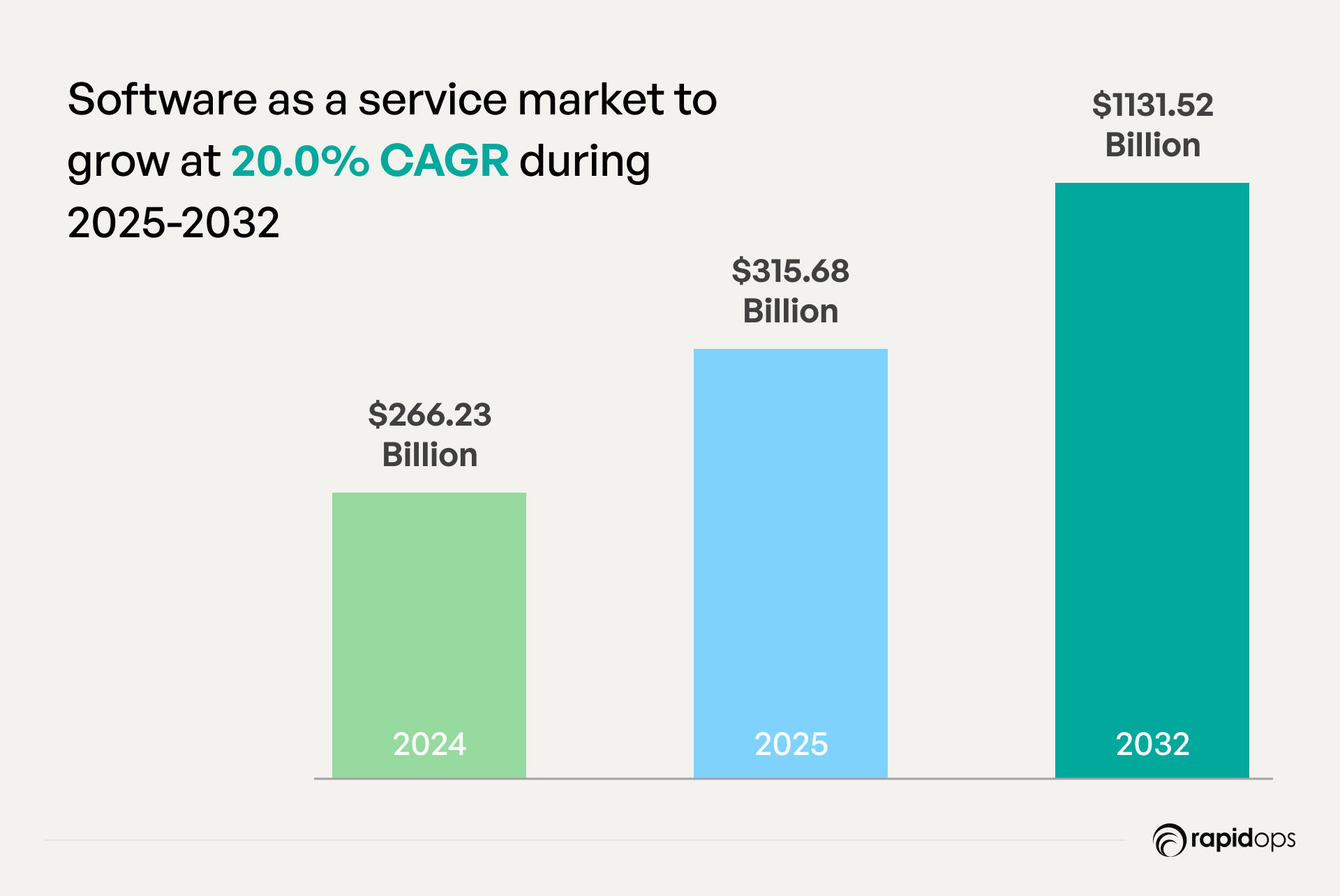
Understanding SaaS: What sets it apart from traditional software
Software as a Service (SaaS) has emerged as a foundational model for modern software delivery, transforming how organizations procure, deploy, and scale digital solutions.
Unlike traditional on-premise software that requires installation, licensing, and in-house infrastructure, SaaS solutions are accessed over the internet, enabling faster time-to-value, lower overhead, and continuous innovation. But what truly differentiates SaaS goes beyond its delivery model, it lies in its architectural principles, operational model, and its impact on enterprise agility.
What is SaaS? Understanding its core characteristics
At its core, Software as a Service (SaaS) is a cloud-based software delivery model in which applications are centrally hosted by a provider and made available to users via the internet. SaaS eliminates the need for organizations to install and maintain software locally. Instead, users subscribe to the service and access the software through a web browser or API, ensuring real-time availability and seamless updates.
Core characteristics of SaaS include:
- On-demand accessibility: SaaS applications are accessible from any device with an internet connection, enabling remote work, collaboration, and global operations.
- Managed infrastructure: The SaaS provider is responsible for hosting, maintaining, and securing the infrastructure, freeing internal IT teams to focus on strategic initiatives.
- Automatic updates and enhancements: Upgrades are delivered continuously without requiring manual intervention, ensuring organizations always use the most secure and feature-rich version.
- Elastic scalability: SaaS platforms can scale horizontally to support spikes in user demand or expansion into new markets without performance degradation.
- Usage-based billing: Subscriptions are typically priced based on usage tiers, active users, or consumption metrics, providing financial flexibility and predictability.
What are the major categories of SaaS products?
If you’re aiming to leverage SaaS to fuel growth and improve efficiency, understanding the key categories of SaaS products is essential. Being aware of the available options and how they align with your unique business needs enables you to make smarter technology decisions that accelerate innovation and deliver measurable results.
Here is a breakdown of the major SaaS categories you need to know to stay competitive in today’s fast-evolving digital landscape.
1. Customer relationship management (CRM)
CRM platforms streamline how organizations manage customer data, sales pipelines, and marketing campaigns. By centralizing customer interactions and automating workflows, CRM SaaS empowers businesses to deliver personalized experiences, accelerate sales cycles, and improve retention.
2. Enterprise resource planning (ERP)
ERP SaaS solutions integrate critical business processes such as finance, procurement, inventory, and supply chain operations into a unified platform. This integration provides real-time visibility, reduces operational silos, and optimizes resource allocation, enabling organizations to respond swiftly to market dynamics.
3. Supply chain management (SCM)
SCM SaaS applications enhance demand forecasting, logistics coordination, and supplier collaboration. Leveraging cloud-based intelligence, these tools help businesses reduce costs, improve delivery timelines, and increase supply chain resilience in an increasingly complex global environment.
4. Human capital management (HCM)
HCM SaaS platforms automate core HR functions including recruitment, payroll, performance management, and employee engagement. They support workforce agility by providing data-driven insights into talent management while ensuring compliance and fostering employee productivity.
5. Analytics and business intelligence (BI)
BI and analytics SaaS tools aggregate and analyze data from diverse sources to provide actionable insights. These platforms enable organizations to uncover market trends, optimize operations, and make evidence-based decisions that fuel competitive advantage.
6. Collaboration and productivity tools
Cloud-native collaboration suites facilitate seamless communication, project management, and document sharing. By enabling distributed teams to work together in real time, these SaaS products accelerate innovation cycles and enhance organizational agility.
Selecting and integrating the right SaaS categories enables businesses to create cohesive, scalable technology ecosystems. This approach not only streamlines operations but also positions organizations to capitalize on emerging opportunities with speed and confidence.
How subscription models, cloud delivery, and multi-tenancy function in SaaS
The SaaS model integrates three foundational components that underpin its operational efficiency and economic value: subscription-based pricing, cloud-native delivery, and multi-tenancy architecture.
1. Subscription models
SaaS applications are typically offered through subscription models monthly, quarterly, or annually. This structure provides:
- Cost predictability: Organizations avoid large upfront capital expenditures and instead pay operational expenses (OpEx) aligned with usage.
- Lower barrier to entry: Businesses of all sizes can adopt enterprise-grade software without the overhead of hardware and setup.
- Customer-centric evolution: Vendors are incentivized to continuously improve their offerings to retain customers, unlike traditional perpetual licenses.
2. Cloud delivery
SaaS applications are deployed on cloud infrastructure public, private, or hybrid and accessed through the internet. Cloud delivery enables:
- Global accessibility: Users can securely access applications across geographies with consistent performance.
- High availability and resilience: Built-in redundancy and failover mechanisms ensure uptime even during outages or maintenance.
- Rapid deployment: New environments can be provisioned in minutes, accelerating digital initiatives and innovation cycles.
3. Multi-tenancy
Multi-tenancy is a key architectural principle where a single instance of the application serves multiple customers (tenants), with each tenant’s data logically isolated.
- Operational efficiency: Shared infrastructure reduces operational overhead and simplifies maintenance for the provider.
- Scalable innovation: Enhancements and bug fixes are rolled out uniformly, ensuring all users benefit simultaneously.
- Security by design: Though tenants share the same environment, robust data segregation policies ensure compliance, privacy, and integrity.
How does SaaS differ from traditional software delivery?
| Dimension | Traditional Software | SaaS |
| Deployment | Installed locally on user systems | Hosted on cloud and accessed via web |
| Ownership model | Perpetual license | Subscription-based |
| Infrastructure | Managed by internal IT | Managed by the provider |
| Updates & maintenance | Manual and periodic | Automatic and continuous |
| Scalability | Hardware-limited; slow to scale | Instantly scalable via cloud resources |
| Accessibility | Device and location dependent | Accessible from anywhere |
How SaaS architecture drives scalability, agility, and cost efficiency
Modern SaaS platforms are underpinned by cloud-native, service-oriented architectures that are designed for elasticity, modularity, and operational intelligence.
Scalability
SaaS systems are built to automatically scale based on demand. Whether supporting ten users or ten million, SaaS architectures use load balancing, auto-provisioning, and elastic storage to maintain performance and responsiveness. This is particularly valuable for organizations experiencing seasonal peaks, rapid growth, or dynamic workloads.
Agility
Because SaaS platforms decouple services using microservices and APIs, they allow for rapid development, testing, and deployment of new features. This modularity enables:
- Faster innovation cycles through CI/CD pipelines
- Quick integration with third-party services and ecosystems
- Adaptability to shifting market and regulatory conditions
SaaS also supports agile business operations by enabling teams to adopt new tools and capabilities with minimal disruption.
Cost efficiency
SaaS models dramatically reduce total cost of ownership (TCO) by:
- Eliminating upfront hardware and licensing costs
- Minimizing internal IT resource allocation for support and maintenance
- Leveraging shared resources across tenants for operational efficiency
- Offering transparent and predictable pricing aligned with actual usage
Moreover, with SaaS, organizations pay only for what they need, with the flexibility to scale up or down as business demands evolve.
SaaS is not just an alternative delivery method, it’s a foundational enabler of digital transformation. Its combination of cloud-native architecture, consumption-based economics, and service-driven agility positions it as the go-to model for enterprises looking to modernize their technology stack, accelerate innovation, and remain resilient in a rapidly changing digital landscape.
Why developing a SaaS product is a strategic business advantage
In an era defined by rapid digital transformation, the Software-as-a-Service (SaaS) model is more than just a modern approach to software delivery, it is a strategic lever for long-term business value creation. For companies building SaaS products, the shift unlocks new pathways to recurring revenue, operational agility, and customer-centric innovation.
Unlike traditional software models, SaaS enables organizations to respond to change dynamically, scale efficiently, and deliver continuous value at global scale. Below, we explore the core reasons why developing a SaaS product positions businesses for sustained competitive advantage.
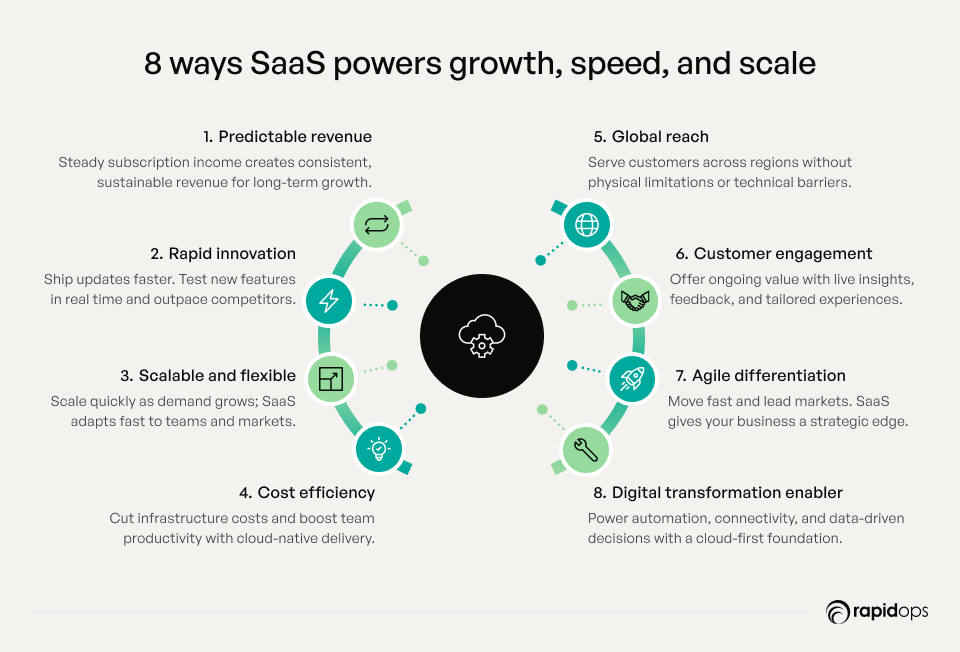
1. Predictable recurring revenue model
At the heart of SaaS is a subscription-based business model that offers revenue visibility and financial stability. For businesses, this recurring revenue stream enables:
- Greater predictability in financial planning and cash flow management
- Stronger investor confidence through consistent revenue projections
- Improved customer lifetime value (CLV) by focusing on retention and upselling
Compared to one-time software sales, SaaS monetization is inherently aligned with long-term customer relationships, incentivizing continuous product improvement and proactive support.
2. Faster innovation cycles
SaaS architecture supports continuous integration and delivery (CI/CD), allowing organizations to:
- Release updates and features in real time
- Test and iterate rapidly based on user feedback
- Respond to evolving market demands and compliance requirements
By decoupling releases from physical installations or client dependencies, product teams can push improvements to all customers simultaneously driving accelerated product evolution and market responsiveness.
3. Scalability and flexibility
Building a SaaS product on cloud-native infrastructure enables horizontal scalability and elastic resource allocation. Businesses can:
- Seamlessly scale user access, storage, and compute power without re-architecting the solution
- Support small teams or enterprise-grade deployments with the same underlying codebase
- Introduce tiered pricing and modular capabilities to serve diverse customer segments
This scalability is particularly advantageous in dynamic markets where demand can spike suddenly or vary by region, customer size, or use case.
4. Cost-effectiveness and resource efficiency
SaaS products eliminate the need for physical distribution, on-premise installation, and customer-specific customizations. This results in:
- Lower infrastructure and maintenance costs for both providers and users
- Centralized management and support, reducing operational overhead
- Shared codebase and multi-tenancy, enabling resource optimization across clients
Developing a SaaS product allows engineering and support teams to focus on core innovation rather than managing fragmented deployments—maximizing return on internal talent and infrastructure.
5. Global accessibility and reach
SaaS products, delivered via the cloud, are inherently global. With minimal localization and regulatory alignment, businesses can:
- Enter new markets faster without the friction of physical infrastructure or regional deployment hurdles
- Offer consistent experiences across geographies and devices
- Serve distributed workforces and customer bases with high availability
This democratizes access to enterprise-grade tools and opens new revenue streams in emerging economies or underserved segments.
6. Stronger customer engagement and retention
With usage-based insights and always-on connectivity, SaaS providers can continuously monitor how customers interact with their products. This unlocks:
- Real-time product telemetry to personalize user journeys and identify friction points
- Proactive customer success and support, driving satisfaction and retention
- Feature usage data to inform product roadmap decisions and drive upsell opportunities
Customer relationships shift from transactional to relational, as SaaS models allow businesses to engage across the full lifecycle, onboarding, adoption, expansion, and renewal.
7. Competitive differentiation through agility
In fast-changing industries, speed and adaptability are strategic weapons. SaaS enables companies to:
- Launch new offerings and enter new verticals with minimal incremental cost
- Respond to competitive threats and shifting user expectations rapidly
- Experiment with new business models (freemium, usage-based, integrations) without retooling core infrastructure
- Agility becomes a differentiator not just in development cycles, but in strategic positioning, market entry, and customer responsiveness.
8. Alignment With digital transformation goals
Developing a SaaS product inherently aligns with enterprise-wide digital transformation initiatives. It supports:
- Cloud-first strategies that reduce legacy system dependencies
- Data-driven decision-making through real-time analytics and telemetry
- Integration with modern digital ecosystems, including APIs, AI/ML models, and external platforms
As businesses modernize operations, build digital experiences, and unlock new value chains, SaaS becomes both the enabler and the outcome of a successful transformation journey.
Building a SaaS product is a strategic leap toward lasting growth and resilience, empowering your business to innovate continuously, adapt swiftly, and create meaningful customer value in a world where agility defines success and future relevance.
Step-by-step SaaS product development process
Building a SaaS product means more than just launching software, it’s about turning a vision into something real, scalable, and deeply valuable. It’s about solving the right problems, for the right users, at the right time. Every step you take should move you closer to a product that not only functions, but earns trust, drives growth, and stands the test of change.
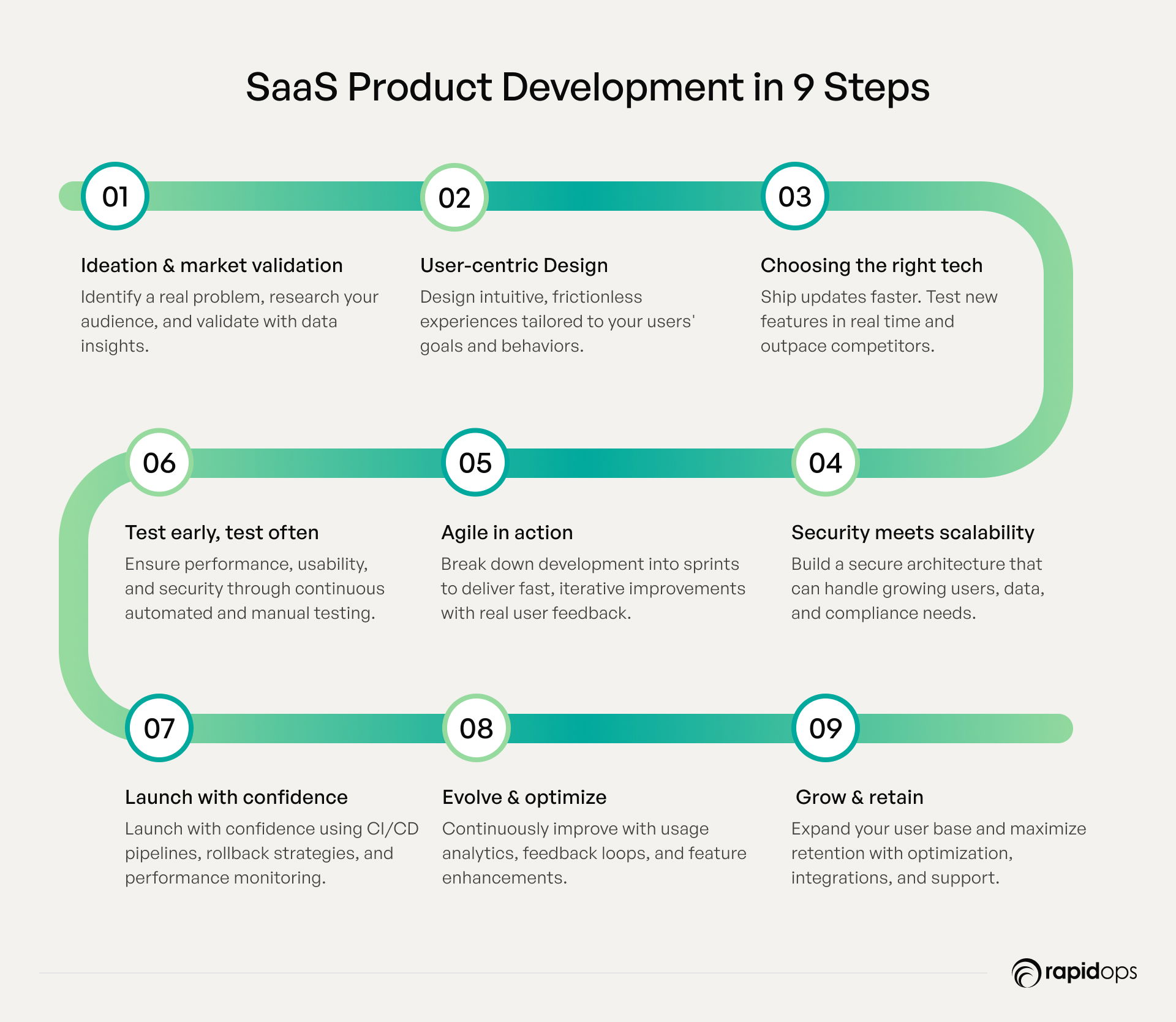
1. Ideation and market validation
Every successful SaaS product starts with solving a real problem for a clearly defined audience. This stage focuses on identifying a market gap and validating it through rigorous research and early feedback loops.
Key actions:
- Conduct customer discovery interviews, competitor analysis, and industry benchmarking
- Develop a minimum viable hypothesis: Who is the user? What pain point are you solving? What’s the measurable impact?
- Use tools like surveys, pilot prototypes, or landing pages to gauge demand before development
By aligning ideation with real-world needs and business fit, you reduce the risk of building features nobody wants and improve product-market alignment from day one.
2. User-centric design
Design isn’t just aesthetics it’s functionality, usability, and engagement. In SaaS, intuitive UX is a product differentiator and a driver of adoption and retention.
Best practices:
- Leverage design thinking methodologies to empathize with end users and map user journeys
- Prioritize simplicity, accessibility, and task flow clarity
- Incorporate feedback loops via early wireframes, clickable prototypes, and usability tests
At this stage, the goal is to design experiences, not just interfaces, ensuring the product naturally integrates into the user's workflow.
3. Choosing the right technology
The long-term success of a SaaS product depends heavily on technical architecture decisions made early on. Flexibility, performance, and integration capability are critical.
Technology choices should consider:
- Cloud-native architecture for elasticity and scalability (e.g., AWS, Azure, GCP)
- Microservices or modular monoliths to support independent feature development and deployment
- API-first approach to enable integration with third-party systems and future extensibility
- Tech stack alignment with in-house skillsets and long-term supportability
A wrong tech foundation can slow down innovation; the right one powers growth, security, and speed.
4. Ensuring data security & scalability
Security and scalability are not afterthoughts; they are built-in requirements. SaaS users trust providers with sensitive data and expect systems to perform under dynamic loads.
Key security & scalability considerations:
- Implement role-based access control (RBAC), encryption (at rest & in transit), and secure APIs
- Ensure compliance with relevant standards such as SOC 2, GDPR, HIPAA, or ISO 27001
- Architect for horizontal scalability, leveraging container orchestration (e.g., Kubernetes) and autoscaling
- Use multi-tenancy best practices to securely serve multiple customers on a shared infrastructure
Embedding security and scalability early protects reputation, supports global scale, and reduces technical debt.
5. Agile development in action
SaaS thrives on continuous improvement and responsiveness, making agile methodologies a perfect fit.
Agile SaaS execution typically involves:
- Sprint-based planning, allowing for fast iteration and feedback-driven development
- Clear product backlog grooming and prioritization based on user needs and business goals
- Cross-functional squads working in parallel on backend, frontend, and DevOps
- Leveraging CI/CD pipelines to automate build, test, and release processes
Agility is not just speed, it’s alignment. It ensures the product evolves as user expectations and market dynamics shift.
6. Comprehensive testing & QA
In the SaaS model, failure isn’t localized, it’s instantly visible across the user base. That’s why robust, automated testing is essential.
A comprehensive QA strategy should include:
- Unit, integration, and end-to-end tests integrated into CI/CD pipelines
- Performance, stress, and load testing to validate scalability under real-world usage
- Security testing including vulnerability scanning and penetration testing
- User acceptance testing (UAT) to ensure new features meet customer expectations
QA isn’t a final phase, it’s embedded across the lifecycle to ensure reliability, security, and consistency.
7. Seamless deployment and launch
A SaaS launch isn’t a single event, it’s the orchestration of go-live readiness, user onboarding, and post-deployment support.
Critical elements:
- Blue-green deployments or canary releases to minimize risk during rollout
- Monitoring and observability tools (e.g., Datadog, New Relic) for real-time issue detection
- Structured onboarding journeys with product tours, documentation, and live support
- Launch feedback loops to capture user input and identify improvement areas from day one
An effective launch builds trust, captures early wins, and sets the tone for ongoing customer engagement.
8. Ongoing management and growth
SaaS is a living product. Post-launch, the focus shifts to optimization, growth, and user retention.
Sustaining success involves:
- Usage analytics to understand feature adoption and user behavior
- Customer success programs to support onboarding, renewals, and upsells
- Feature enhancement based on roadmap prioritization and customer feedback
- Scalable infrastructure optimization to maintain performance as adoption grows
- Continuous security updates, compliance monitoring, and incident response readiness
The most successful SaaS products treat this phase not as maintenance, but as evolution. Success in SaaS isn’t a one-time event; it’s a continuous commitment to evolving with your users, your market, and your mission.
When you approach development with intention, clarity, and adaptability, you don’t just deliver a product; you create momentum. The kind that sets you apart keeps customers coming back, and turns your product into a platform for long-term leadership.
Key considerations when getting your SaaS product developed
When embarking on SaaS product development, there are crucial factors that you must keep in mind. These elements directly influence the success, timeline, cost, and quality of your product, making it essential to address them early and thoroughly.
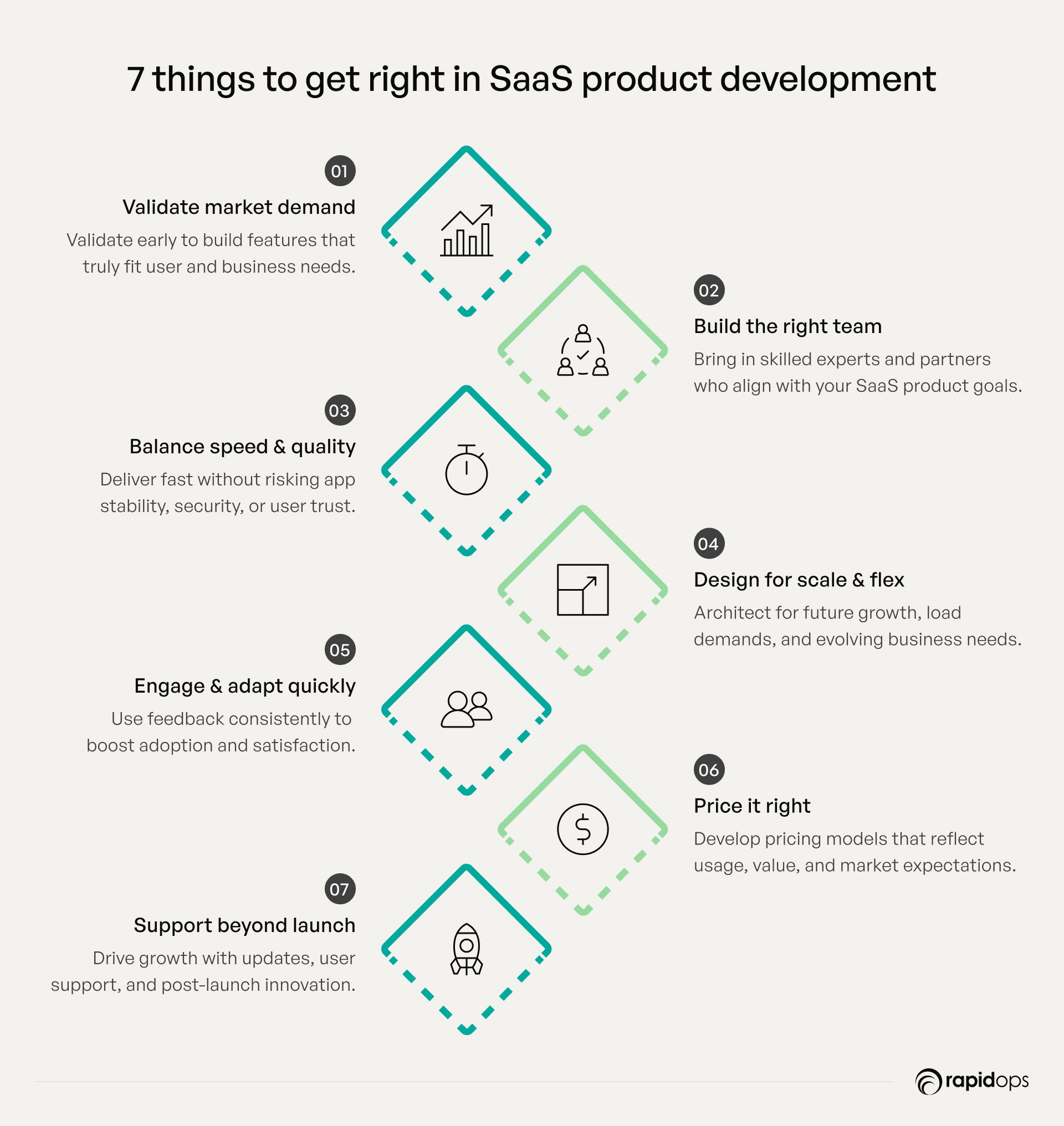
Validating market demand and business alignment
It’s critical to ensure your SaaS product idea aligns with genuine market needs and your business objectives. Overlooking this can lead to wasted resources on features that don’t resonate with users or support your strategic goals. Early, rigorous market validation keeps development focused and relevant.
Assembling the right team and trusted partners
Your SaaS development success depends on having a multidisciplinary team with the right expertise, from engineering and UX design to security and business strategy. Selecting reliable partners and skilled talent is key. Without the right people, coordination gaps or capability mismatches can delay development and impact quality.
Balancing speed with quality and security
Rapid delivery is important, but rushing can compromise product stability or expose security vulnerabilities. Mindful planning is necessary to maintain this balance, ensuring features are rolled out quickly without sacrificing thorough testing, compliance, or risk management.
Architecting for scalability and flexibility
SaaS products must be built on architectures that can smoothly handle user growth, fluctuating workloads, and evolving business needs. Failing to consider scalability and flexibility early can lead to costly reworks or performance bottlenecks as your user base expands.
Driving continuous user engagement and feedback loops
Sustaining long-term success requires mechanisms to capture and act on user feedback continuously. Ignoring this can reduce adoption and retention. Establishing effective feedback channels helps you iterate efficiently, keeping the product aligned with user expectations.
Optimizing pricing and revenue models
Pricing strategies impact adoption and profitability significantly. It’s important to consider customer segments, usage patterns, and market dynamics to develop flexible, competitive pricing. Missteps here can lead to lost revenue or customer churn.
Ensuring post-launch support and continuous innovation
Development doesn’t end at launch. Planning for ongoing support, timely updates, and feature enhancements is vital to maintaining uptime, satisfying customers, and staying ahead of competitors. Neglecting this aspect can undermine the product’s value and growth potential.
Critical success factors for delivering real business value with SaaS
Delivering real business value with SaaS goes beyond cloud deployment, it requires focusing on key success factors that align product performance with customer needs, operational excellence, and compliance. These elements are essential for sustained growth and market differentiation.
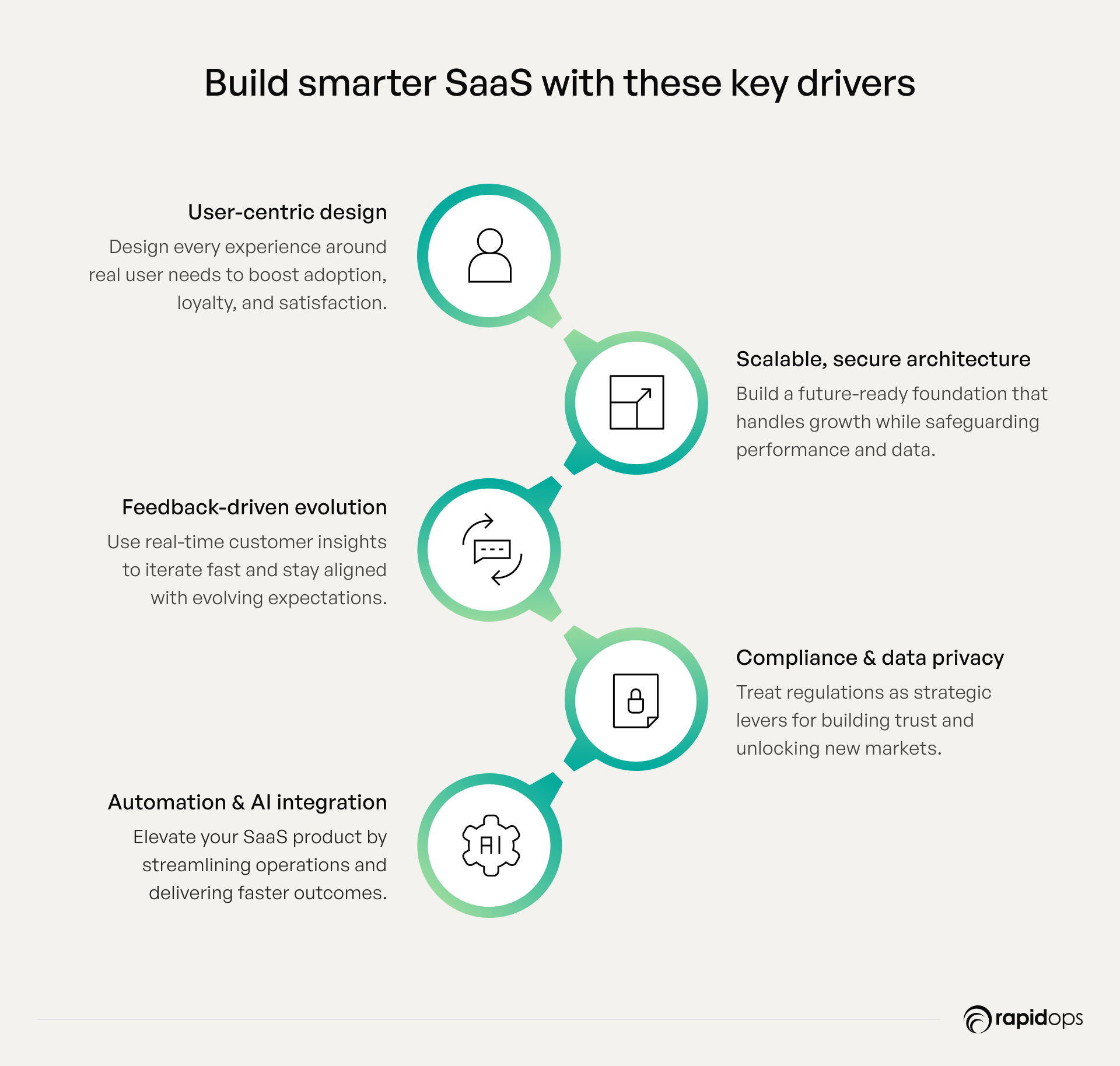
1. Prioritizing user-centric design for superior customer experience
User experience (UX) stands at the heart of SaaS value creation. A user-centric design approach ensures that the product intuitively addresses real-world problems, reduces friction, and accelerates adoption.
This requires continuous engagement with end-users throughout development, leveraging persona-driven design, and seamless, consistent interfaces across devices. Prioritizing usability directly impacts customer satisfaction, retention, and lifetime value, transforming users into advocates and reducing churn.
2. Ensuring architecture is scalable, secure, and resilient
SaaS architectures must support rapid growth and dynamic workloads without compromising performance or reliability. Scalability ensures the platform can handle increasing user demand and data volumes, while resilient design minimizes downtime through fault tolerance and disaster recovery mechanisms.
Security is non-negotiable, robust encryption, identity management, and threat detection safeguard customer data and maintain trust. Together, these elements build a dependable foundation that aligns operational integrity with business agility.
3. Leveraging customer feedback and analytics for continuous improvement
Real-time data and customer insights fuel continuous product refinement. Integrating advanced analytics enables organizations to monitor usage patterns, identify pain points, and prioritize feature enhancements based on quantifiable impact.
Systematic feedback loops from in-app surveys to behavior tracking empower teams to respond swiftly to shifting needs, ensuring the product evolves in tandem with its user base. This data-driven agility drives sustained relevance and competitive advantage.
4. Meeting compliance and data privacy regulations as a trust and competitive factor
In an era of stringent data protection laws such as GDPR and CCPA, compliance is both a regulatory mandate and a strategic differentiator. Adhering to privacy standards requires embedding compliance controls into the SaaS lifecycle, from data collection and storage to processing and breach response.
Transparent data practices reinforce customer trust and unlock opportunities in regulated industries, where security certifications and audit readiness can become decisive competitive advantages.
5. Incorporating Automation and AI to Enhance Product Capabilities and Operational Efficiency
Automation and artificial intelligence elevate SaaS offerings by streamlining repetitive tasks, optimizing resource allocation, and enabling predictive insights. AI-driven features, such as personalized recommendations, anomaly detection, and intelligent workflows, improve user engagement while reducing operational overhead.
Moreover, automated deployment pipelines and self-healing infrastructure accelerate innovation cycles and maintain high service levels, ensuring the SaaS product remains both cutting-edge and cost-effective.
Your SaaS vision, realized through trusted expertise and partnership
You’ve explored the critical elements of SaaS product development, from building a clear, customer-centered strategy to navigating the technical, operational, and market-driven challenges that shape success. At this point, you’re not just informed. You’re equipped to recognize what’s essential, what’s changing, and what’s truly at stake.
But if you’re like most product and technology leaders, you know that insight alone isn’t the finish line. It’s the starting point. The real challenge lies in translating that insight into execution, making the right architectural decisions, aligning your roadmap with customer outcomes, and adapting quickly when priorities shift.
That’s where the right partner makes a difference.
At Rapidops, we work alongside forward-thinking teams to navigate complexity with confidence. With 16 years of experience building and scaling SaaS platforms across industries, we’ve seen how product decisions play out in the real world, where resilience, security, and scalability define market relevance. We understand the trade-offs, the constraints, and the pressure to deliver.
If you’re at a decision point on whether to double down, pivot, or accelerate your roadmap, consider booking a free, one-on-one consultation with one of our SaaS product experts. We’ll take the time to understand where you are, what’s holding you back, and how you can move forward with clarity on your terms aligned with your vision.

Rahul Chaudhary
Content Writer
With 5 years of experience in AI, software, and digital transformation, I’m passionate about making complex concepts easy to understand and apply. I create content that speaks to business leaders, offering practical, data-driven solutions that help you tackle real challenges and make informed decisions that drive growth.
What’s Inside
- Understanding SaaS: What sets it apart from traditional software
- Why developing a SaaS product is a strategic business advantage
- Step-by-step SaaS product development process
- Key considerations when getting your SaaS product developed
- Critical success factors for delivering real business value with SaaS
- Your SaaS vision, realized through trusted expertise and partnership

Let’s build the next big thing!
Share your ideas and vision with us to explore your digital opportunities
Similar Stories
- Engineering
- undefined Mins
- September 2022

- Engineering
- undefined Mins
- January 2016
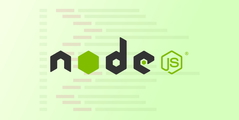
- Engineering
- 5 Mins
- November 2015
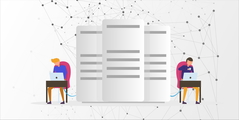

Receive articles like this in your mailbox
Sign up to get weekly insights & inspiration in your inbox.
